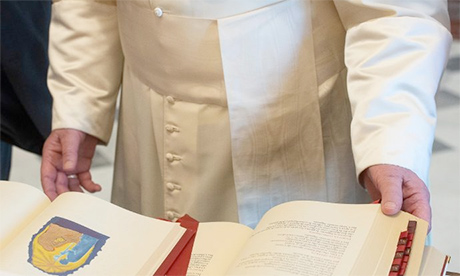Jesus’ blood was poured out “per tutti” – “for all” rather than “per molti”, meaning “for many”, according to the new Italian Missal presented to Pope Francis on 28 August.
The pope normally celebrates Mass in Italian.
The approved Italian translation from Latin of the new Roman Missal comes nine years after the English version was controversially released.
The English translation of the missal, uses the phrase “for many,” suggesting, on the face of it, Jesus did not shed his blood for all.
The change of just two words in the Italian translation is a hallmark of Francis’ papacy according to Christopher Lamb, the Rome Correspondent for The Tablet.
In 2006, Rome ruled that “pro multis” should be translated as “for many” with Benedict XVI insistent on this point, however the Italian bishops held out, resisting Rome and voted overwhelmingly to keep the “for all” phrase.
The consistent theme of the Francis pontificate is that God’s mercy is all-embracing, and the Church is a field hospital welcoming all sinners. No one is excluded, says Lamb.
“Although a less literal translation of the Latin, the phrase ‘for all’ better reflects the teaching that Christ’s sacrifice was for the whole of humanity, and is in keeping with Vatican II.
“As the old Latin motto explains: lex orandi, lex credendi. The rule of prayer is the rule of belief,” comments Lamb.
Bishop Claudio Maniago, president of the Italian bishops’ liturgy commission, said the commission worked hard to remain faithful to the Latin text.
There was “also, and most of all, an effort to render the text as usable as possible and, so, also make it an instrument of growth for the Italian church,” he said.
Admitting there were also some changes to the Our Father and Gloria, Maniago said the bishops worked hard to keep changes to the people’s prayers to a minimum.
He said the differences in the Italian translation have been thoroughly discussed with the Congregation for Divine Worship and the Sacraments.
This is the same body the English translation was discussed with.
Controversy and confusion
Controversy surrounded the 2011 release of the English translation, some calling it “wooden”, “archaic” and “inflated”.
Others accused the translators of producing convoluted syntax.
In 2015, Emeritus Bishop of Palmerston North, Peter Cullinane, called for an overhaul of the new English Missal.
Cullinane told the London Tablet the translation was clunky, awkward and a too literal translation of the Latin original.
In 2017 the New Zealand Bishops’ Conference responded to widespread criticism of the translation saying it hoped for liturgical texts that are both accurate and that speak to the heart.
Later in 2017, in “Magnum Principium” Francis removed the requirement that Rome authorise every aspect of translations; instead, its role is to review translations that have been commissioned and approved by the bishops’ conference.
Removing Rome’s authorisation mandate is consistent with Francis “manifesto” document number 32 in Evangelii Gaudium, where he writes “Excessive centralisation complicates the Church’s life and her missionary outreach.”
“When it comes to the wordings of prayers, it is the bishops on the ground, not curial officials in Rome, who are the best judges of what is going to most effectively aid evangelisation,” explains Lamb.
Twenty years after the work of the Italian translation began and ten years after the English edition was released, priests in Italy will use the new Italian translation from Easter 2021.
Sources
Additional readingNews category: World.




